MERCEDES-BENZ SPRINTER 2006 Service Manual
Manufacturer: MERCEDES-BENZ, Model Year: 2006, Model line: SPRINTER, Model: MERCEDES-BENZ SPRINTER 2006Pages: 2305, PDF Size: 48.12 MB
Page 1661 of 2305
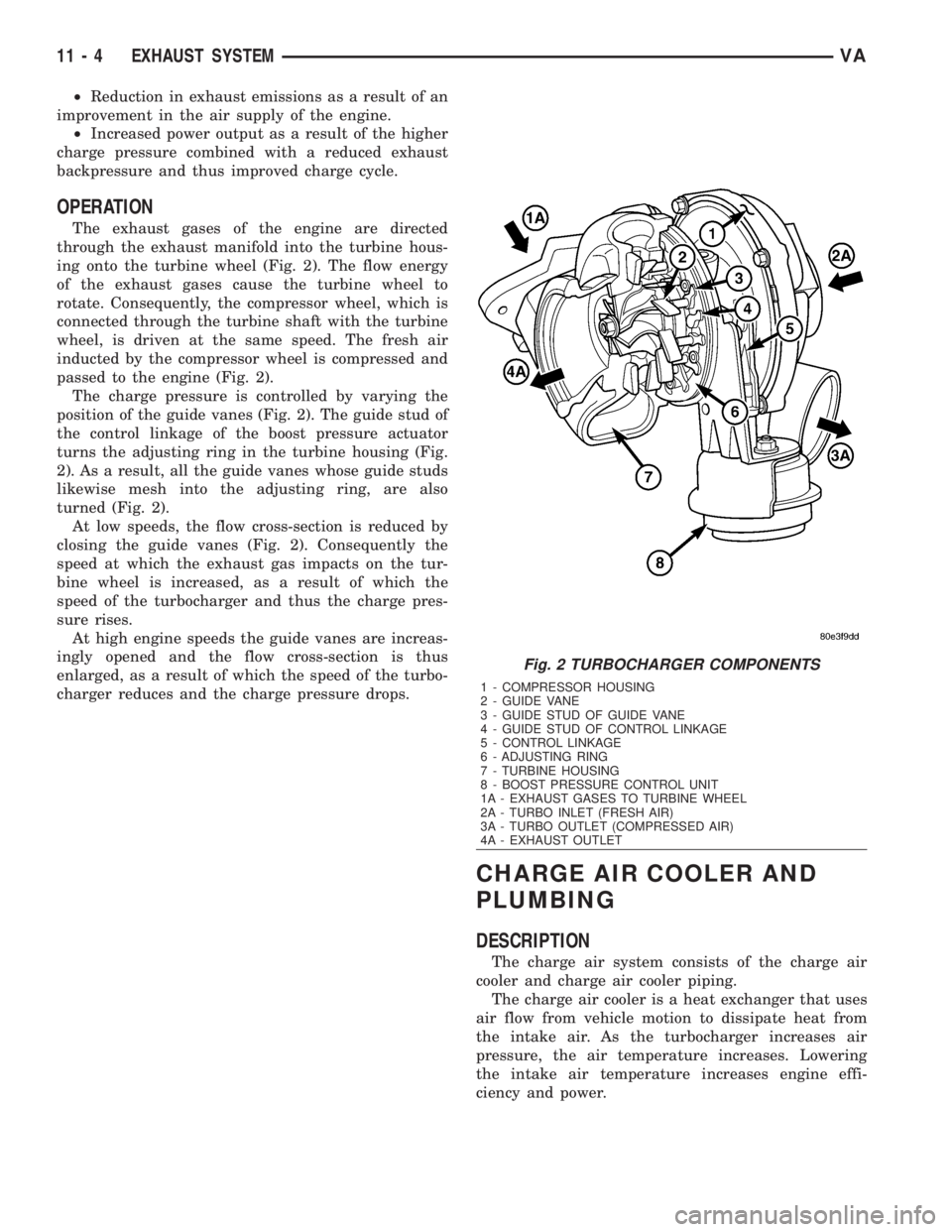
²Reduction in exhaust emissions as a result of an
improvement in the air supply of the engine.
²Increased power output as a result of the higher
charge pressure combined with a reduced exhaust
backpressure and thus improved charge cycle.
OPERATION
The exhaust gases of the engine are directed
through the exhaust manifold into the turbine hous-
ing onto the turbine wheel (Fig. 2). The flow energy
of the exhaust gases cause the turbine wheel to
rotate. Consequently, the compressor wheel, which is
connected through the turbine shaft with the turbine
wheel, is driven at the same speed. The fresh air
inducted by the compressor wheel is compressed and
passed to the engine (Fig. 2).
The charge pressure is controlled by varying the
position of the guide vanes (Fig. 2). The guide stud of
the control linkage of the boost pressure actuator
turns the adjusting ring in the turbine housing (Fig.
2). As a result, all the guide vanes whose guide studs
likewise mesh into the adjusting ring, are also
turned (Fig. 2).
At low speeds, the flow cross-section is reduced by
closing the guide vanes (Fig. 2). Consequently the
speed at which the exhaust gas impacts on the tur-
bine wheel is increased, as a result of which the
speed of the turbocharger and thus the charge pres-
sure rises.
At high engine speeds the guide vanes are increas-
ingly opened and the flow cross-section is thus
enlarged, as a result of which the speed of the turbo-
charger reduces and the charge pressure drops.
CHARGE AIR COOLER AND
PLUMBING
DESCRIPTION
The charge air system consists of the charge air
cooler and charge air cooler piping.
The charge air cooler is a heat exchanger that uses
air flow from vehicle motion to dissipate heat from
the intake air. As the turbocharger increases air
pressure, the air temperature increases. Lowering
the intake air temperature increases engine effi-
ciency and power.
Fig. 2 TURBOCHARGER COMPONENTS
1 - COMPRESSOR HOUSING
2 - GUIDE VANE
3 - GUIDE STUD OF GUIDE VANE
4 - GUIDE STUD OF CONTROL LINKAGE
5 - CONTROL LINKAGE
6 - ADJUSTING RING
7 - TURBINE HOUSING
8 - BOOST PRESSURE CONTROL UNIT
1A - EXHAUST GASES TO TURBINE WHEEL
2A - TURBO INLET (FRESH AIR)
3A - TURBO OUTLET (COMPRESSED AIR)
4A - EXHAUST OUTLET
11 - 4 EXHAUST SYSTEMVA
Page 1662 of 2305
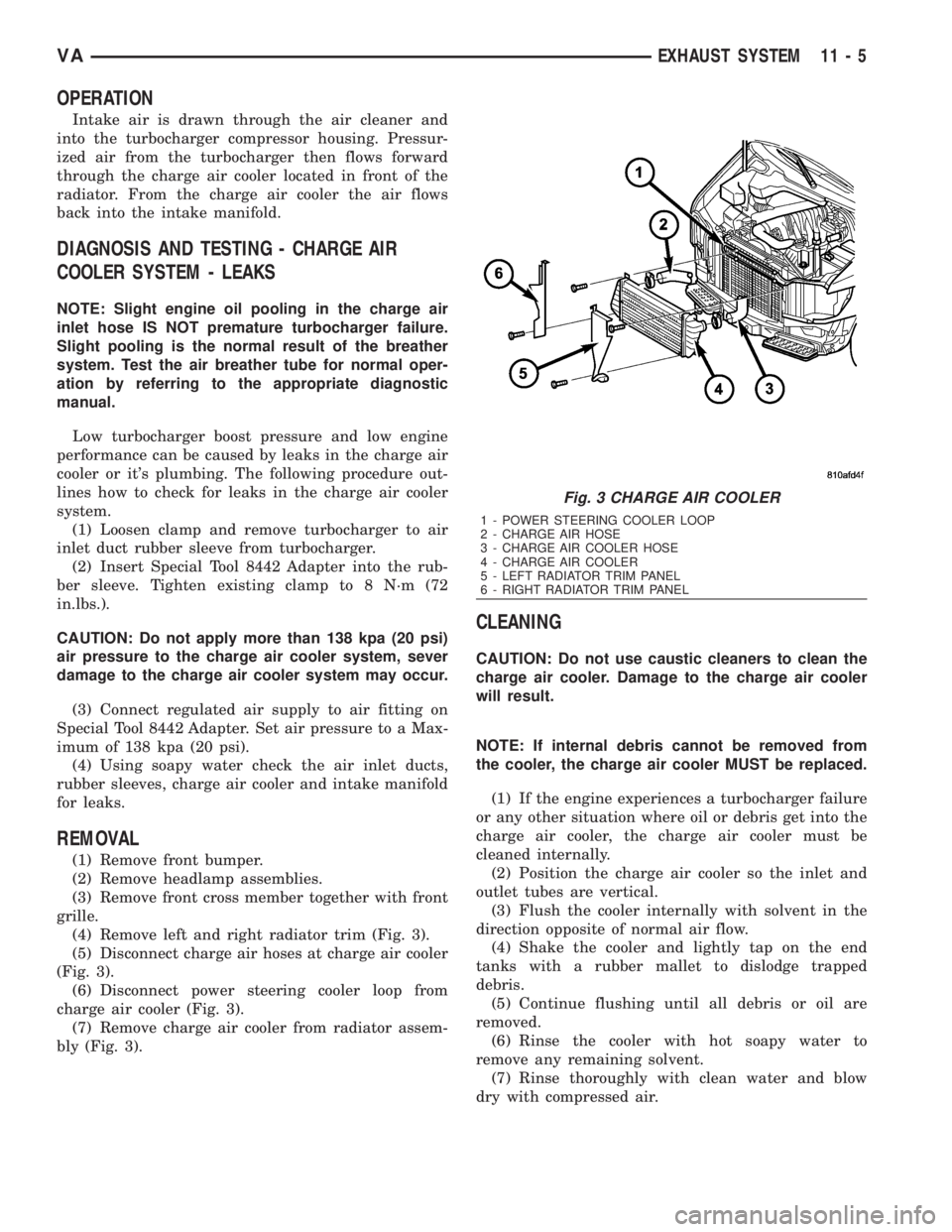
OPERATION
Intake air is drawn through the air cleaner and
into the turbocharger compressor housing. Pressur-
ized air from the turbocharger then flows forward
through the charge air cooler located in front of the
radiator. From the charge air cooler the air flows
back into the intake manifold.
DIAGNOSIS AND TESTING - CHARGE AIR
COOLER SYSTEM - LEAKS
NOTE: Slight engine oil pooling in the charge air
inlet hose IS NOT premature turbocharger failure.
Slight pooling is the normal result of the breather
system. Test the air breather tube for normal oper-
ation by referring to the appropriate diagnostic
manual.
Low turbocharger boost pressure and low engine
performance can be caused by leaks in the charge air
cooler or it's plumbing. The following procedure out-
lines how to check for leaks in the charge air cooler
system.
(1) Loosen clamp and remove turbocharger to air
inlet duct rubber sleeve from turbocharger.
(2) Insert Special Tool 8442 Adapter into the rub-
ber sleeve. Tighten existing clamp to 8 N´m (72
in.lbs.).
CAUTION: Do not apply more than 138 kpa (20 psi)
air pressure to the charge air cooler system, sever
damage to the charge air cooler system may occur.
(3) Connect regulated air supply to air fitting on
Special Tool 8442 Adapter. Set air pressure to a Max-
imum of 138 kpa (20 psi).
(4) Using soapy water check the air inlet ducts,
rubber sleeves, charge air cooler and intake manifold
for leaks.
REMOVAL
(1) Remove front bumper.
(2) Remove headlamp assemblies.
(3) Remove front cross member together with front
grille.
(4) Remove left and right radiator trim (Fig. 3).
(5) Disconnect charge air hoses at charge air cooler
(Fig. 3).
(6) Disconnect power steering cooler loop from
charge air cooler (Fig. 3).
(7) Remove charge air cooler from radiator assem-
bly (Fig. 3).
CLEANING
CAUTION: Do not use caustic cleaners to clean the
charge air cooler. Damage to the charge air cooler
will result.
NOTE: If internal debris cannot be removed from
the cooler, the charge air cooler MUST be replaced.
(1) If the engine experiences a turbocharger failure
or any other situation where oil or debris get into the
charge air cooler, the charge air cooler must be
cleaned internally.
(2) Position the charge air cooler so the inlet and
outlet tubes are vertical.
(3) Flush the cooler internally with solvent in the
direction opposite of normal air flow.
(4) Shake the cooler and lightly tap on the end
tanks with a rubber mallet to dislodge trapped
debris.
(5) Continue flushing until all debris or oil are
removed.
(6) Rinse the cooler with hot soapy water to
remove any remaining solvent.
(7) Rinse thoroughly with clean water and blow
dry with compressed air.
Fig. 3 CHARGE AIR COOLER
1 - POWER STEERING COOLER LOOP
2 - CHARGE AIR HOSE
3 - CHARGE AIR COOLER HOSE
4 - CHARGE AIR COOLER
5 - LEFT RADIATOR TRIM PANEL
6 - RIGHT RADIATOR TRIM PANEL
VAEXHAUST SYSTEM 11 - 5
Page 1663 of 2305
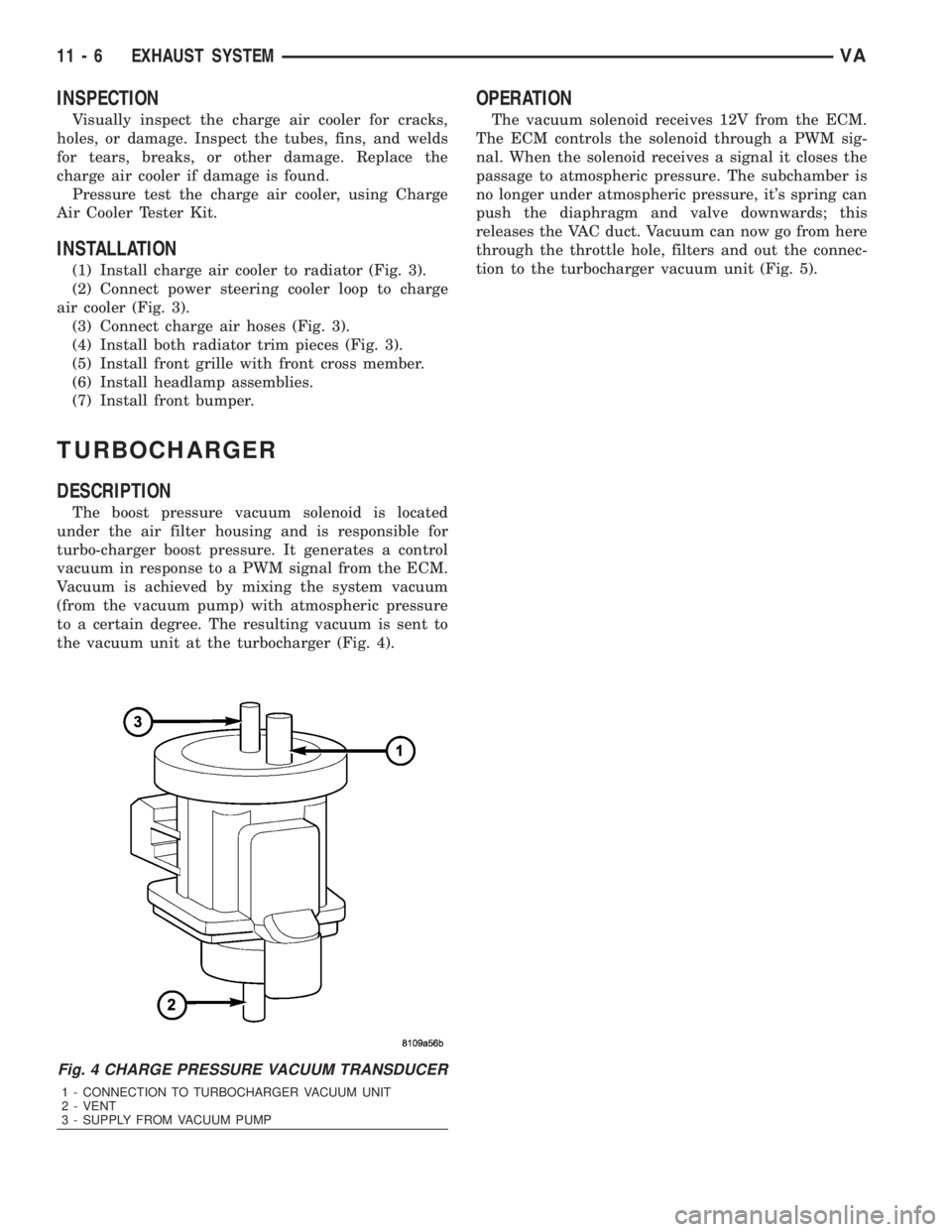
INSPECTION
Visually inspect the charge air cooler for cracks,
holes, or damage. Inspect the tubes, fins, and welds
for tears, breaks, or other damage. Replace the
charge air cooler if damage is found.
Pressure test the charge air cooler, using Charge
Air Cooler Tester Kit.
INSTALLATION
(1) Install charge air cooler to radiator (Fig. 3).
(2) Connect power steering cooler loop to charge
air cooler (Fig. 3).
(3) Connect charge air hoses (Fig. 3).
(4) Install both radiator trim pieces (Fig. 3).
(5) Install front grille with front cross member.
(6) Install headlamp assemblies.
(7) Install front bumper.
TURBOCHARGER
DESCRIPTION
The boost pressure vacuum solenoid is located
under the air filter housing and is responsible for
turbo-charger boost pressure. It generates a control
vacuum in response to a PWM signal from the ECM.
Vacuum is achieved by mixing the system vacuum
(from the vacuum pump) with atmospheric pressure
to a certain degree. The resulting vacuum is sent to
the vacuum unit at the turbocharger (Fig. 4).
OPERATION
The vacuum solenoid receives 12V from the ECM.
The ECM controls the solenoid through a PWM sig-
nal. When the solenoid receives a signal it closes the
passage to atmospheric pressure. The subchamber is
no longer under atmospheric pressure, it's spring can
push the diaphragm and valve downwards; this
releases the VAC duct. Vacuum can now go from here
through the throttle hole, filters and out the connec-
tion to the turbocharger vacuum unit (Fig. 5).
Fig. 4 CHARGE PRESSURE VACUUM TRANSDUCER
1 - CONNECTION TO TURBOCHARGER VACUUM UNIT
2 - VENT
3 - SUPPLY FROM VACUUM PUMP
11 - 6 EXHAUST SYSTEMVA
Page 1664 of 2305
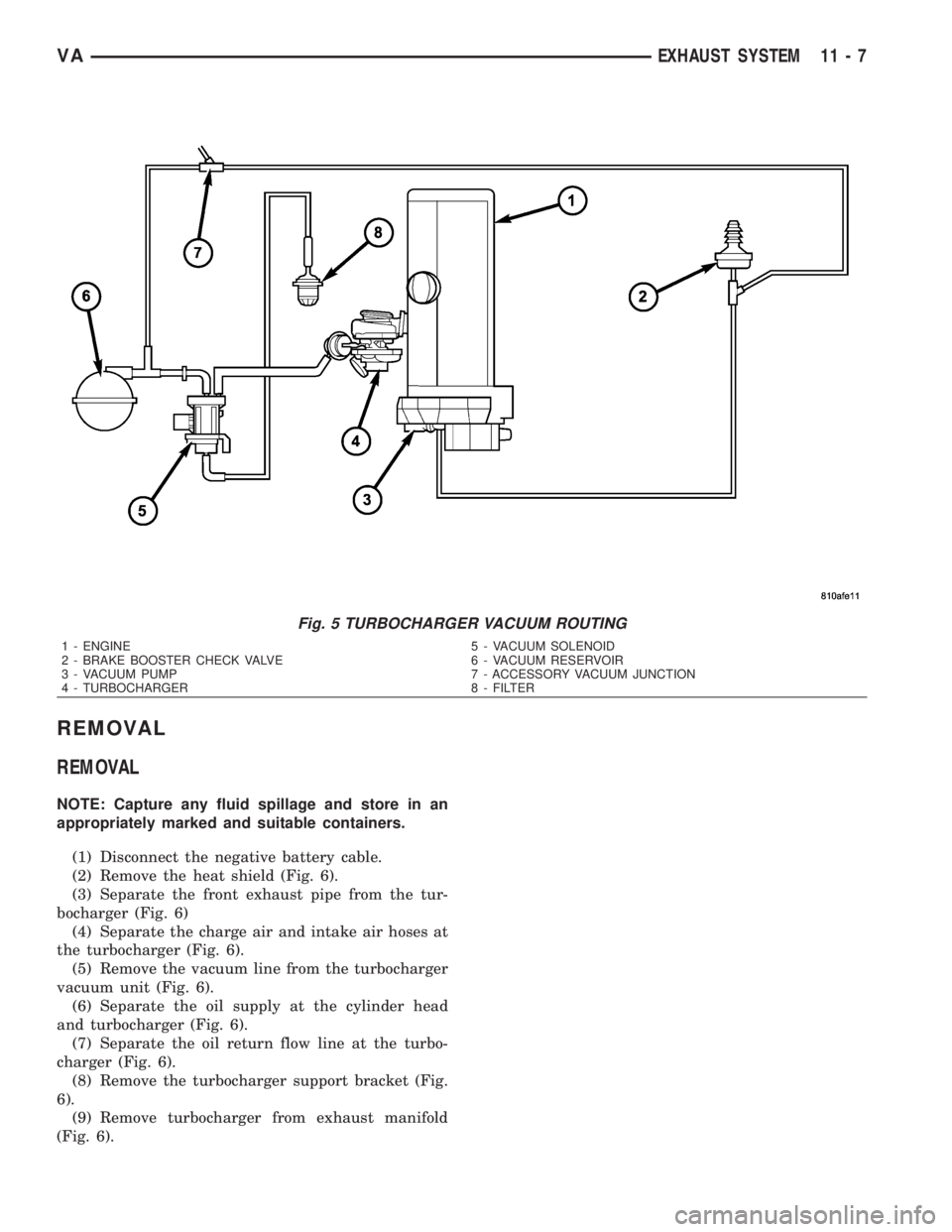
REMOVAL
REMOVAL
NOTE: Capture any fluid spillage and store in an
appropriately marked and suitable containers.
(1) Disconnect the negative battery cable.
(2) Remove the heat shield (Fig. 6).
(3) Separate the front exhaust pipe from the tur-
bocharger (Fig. 6)
(4) Separate the charge air and intake air hoses at
the turbocharger (Fig. 6).
(5) Remove the vacuum line from the turbocharger
vacuum unit (Fig. 6).
(6) Separate the oil supply at the cylinder head
and turbocharger (Fig. 6).
(7) Separate the oil return flow line at the turbo-
charger (Fig. 6).
(8) Remove the turbocharger support bracket (Fig.
6).
(9) Remove turbocharger from exhaust manifold
(Fig. 6).
Fig. 5 TURBOCHARGER VACUUM ROUTING
1 - ENGINE 5 - VACUUM SOLENOID
2 - BRAKE BOOSTER CHECK VALVE 6 - VACUUM RESERVOIR
3 - VACUUM PUMP 7 - ACCESSORY VACUUM JUNCTION
4 - TURBOCHARGER 8 - FILTER
VAEXHAUST SYSTEM 11 - 7
Page 1665 of 2305
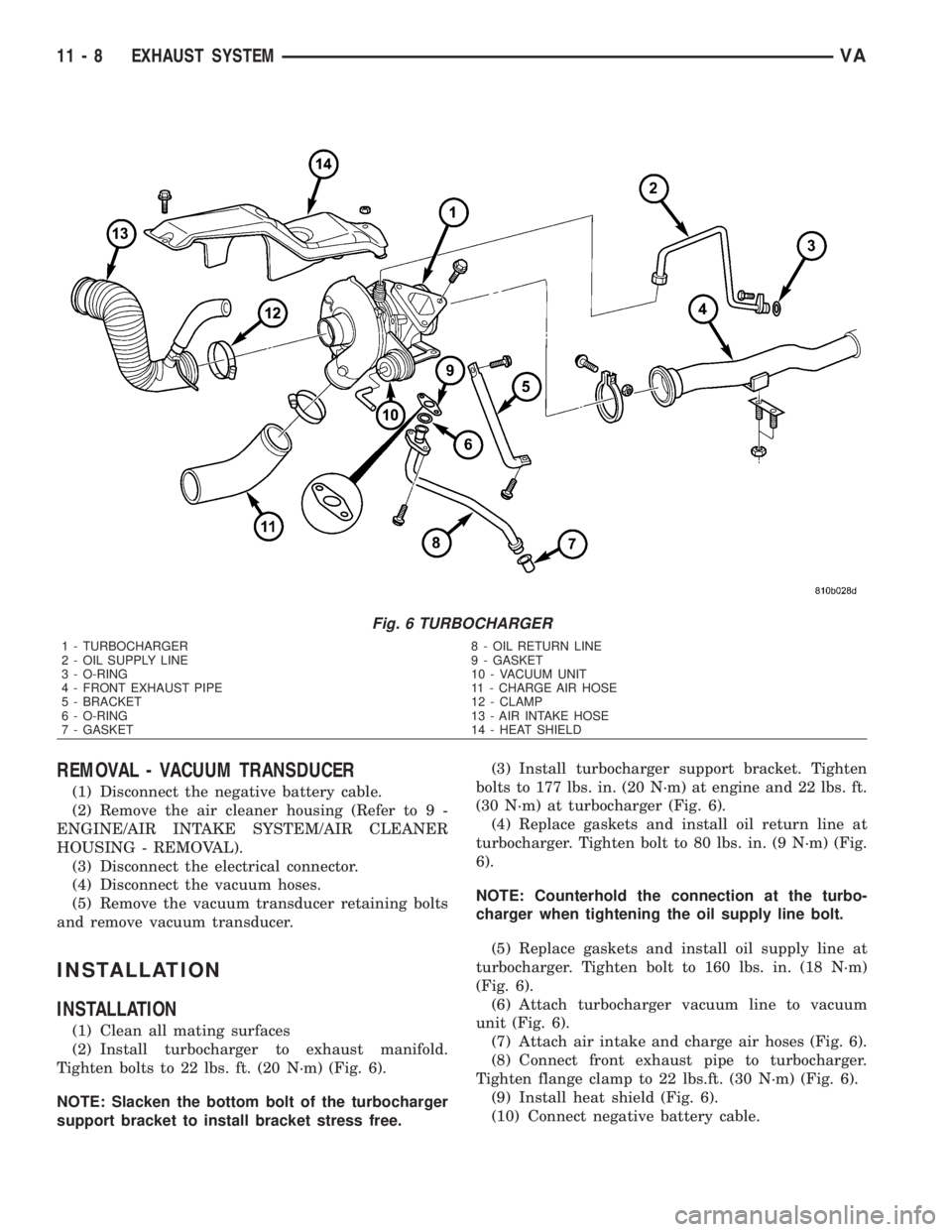
REMOVAL - VACUUM TRANSDUCER
(1) Disconnect the negative battery cable.
(2) Remove the air cleaner housing (Refer to 9 -
ENGINE/AIR INTAKE SYSTEM/AIR CLEANER
HOUSING - REMOVAL).
(3) Disconnect the electrical connector.
(4) Disconnect the vacuum hoses.
(5) Remove the vacuum transducer retaining bolts
and remove vacuum transducer.
INSTALLATION
INSTALLATION
(1) Clean all mating surfaces
(2) Install turbocharger to exhaust manifold.
Tighten bolts to 22 lbs. ft. (20 N´m) (Fig. 6).
NOTE: Slacken the bottom bolt of the turbocharger
support bracket to install bracket stress free.(3) Install turbocharger support bracket. Tighten
bolts to 177 lbs. in. (20 N´m) at engine and 22 lbs. ft.
(30 N´m) at turbocharger (Fig. 6).
(4) Replace gaskets and install oil return line at
turbocharger. Tighten bolt to 80 lbs. in. (9 N´m) (Fig.
6).
NOTE: Counterhold the connection at the turbo-
charger when tightening the oil supply line bolt.
(5) Replace gaskets and install oil supply line at
turbocharger. Tighten bolt to 160 lbs. in. (18 N´m)
(Fig. 6).
(6) Attach turbocharger vacuum line to vacuum
unit (Fig. 6).
(7) Attach air intake and charge air hoses (Fig. 6).
(8) Connect front exhaust pipe to turbocharger.
Tighten flange clamp to 22 lbs.ft. (30 N´m) (Fig. 6).
(9) Install heat shield (Fig. 6).
(10) Connect negative battery cable.
Fig. 6 TURBOCHARGER
1 - TURBOCHARGER 8 - OIL RETURN LINE
2 - OIL SUPPLY LINE 9 - GASKET
3 - O-RING 10 - VACUUM UNIT
4 - FRONT EXHAUST PIPE 11 - CHARGE AIR HOSE
5 - BRACKET 12 - CLAMP
6 - O-RING 13 - AIR INTAKE HOSE
7 - GASKET 14 - HEAT SHIELD
11 - 8 EXHAUST SYSTEMVA
Page 1666 of 2305
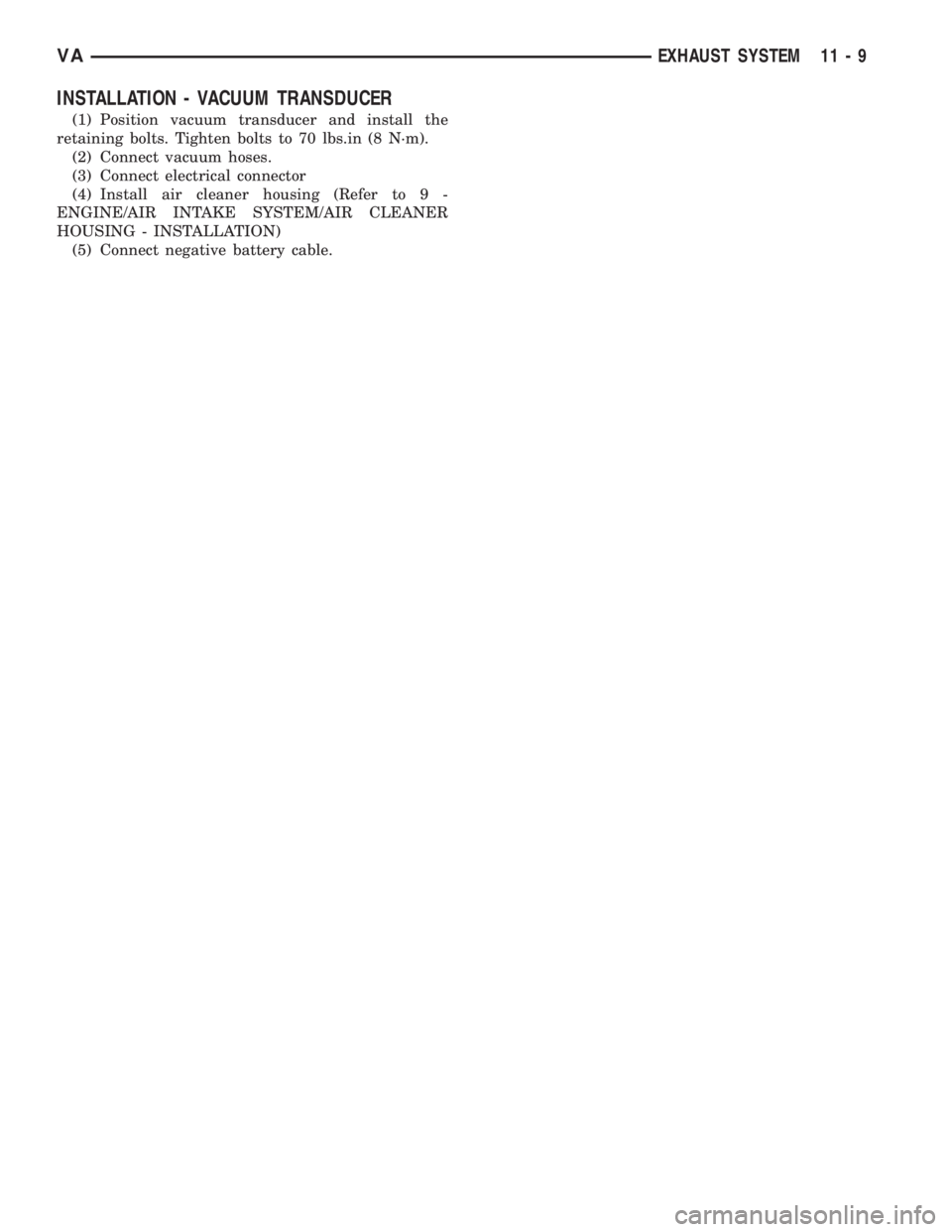
INSTALLATION - VACUUM TRANSDUCER
(1) Position vacuum transducer and install the
retaining bolts. Tighten bolts to 70 lbs.in (8 N´m).
(2) Connect vacuum hoses.
(3) Connect electrical connector
(4) Install air cleaner housing (Refer to 9 -
ENGINE/AIR INTAKE SYSTEM/AIR CLEANER
HOUSING - INSTALLATION)
(5) Connect negative battery cable.
VAEXHAUST SYSTEM 11 - 9
Page 1667 of 2305
Page 1668 of 2305
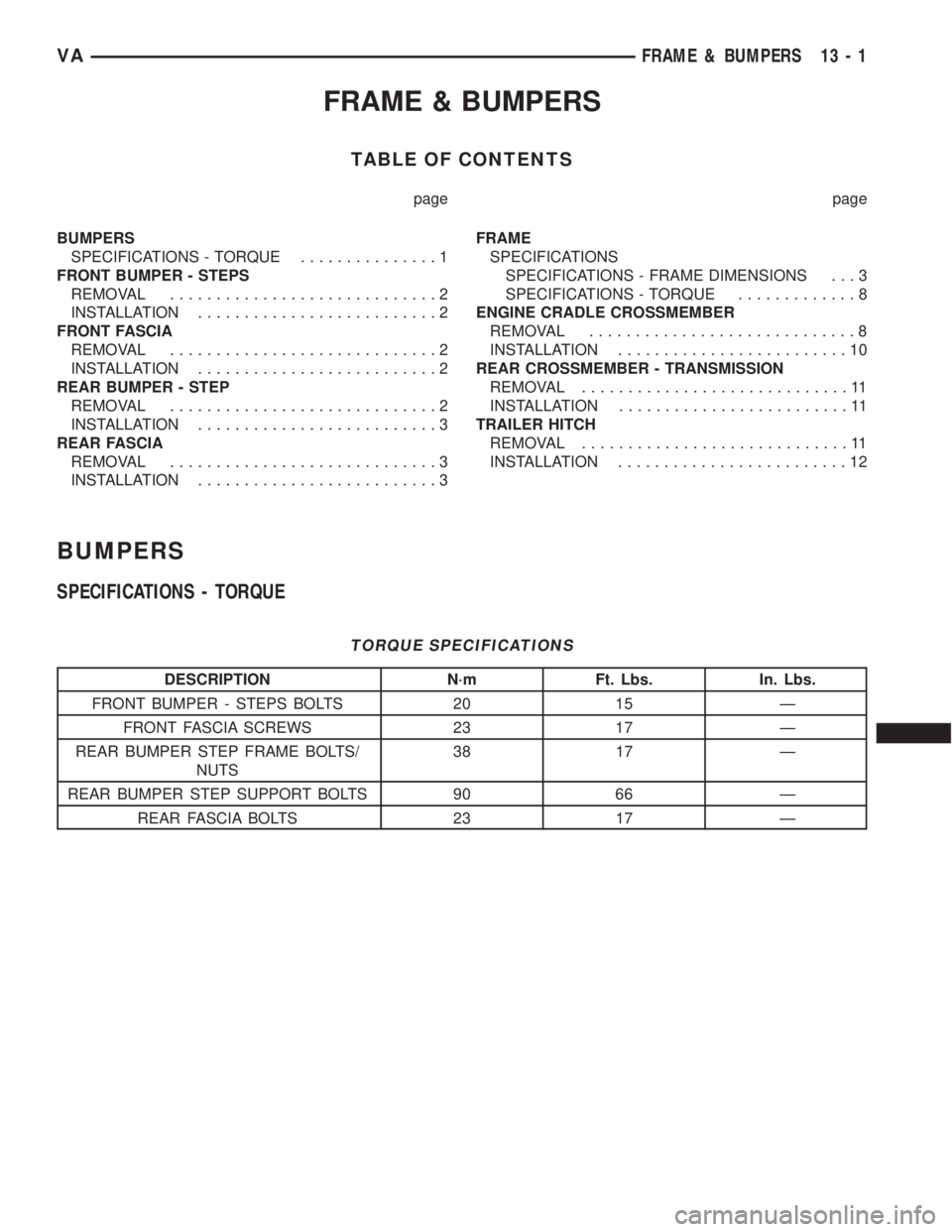
FRAME & BUMPERS
TABLE OF CONTENTS
page page
BUMPERS
SPECIFICATIONS - TORQUE...............1
FRONT BUMPER - STEPS
REMOVAL.............................2
INSTALLATION..........................2
FRONT FASCIA
REMOVAL.............................2
INSTALLATION..........................2
REAR BUMPER - STEP
REMOVAL.............................2
INSTALLATION..........................3
REAR FASCIA
REMOVAL.............................3
INSTALLATION..........................3FRAME
SPECIFICATIONS
SPECIFICATIONS - FRAME DIMENSIONS . . . 3
SPECIFICATIONS - TORQUE.............8
ENGINE CRADLE CROSSMEMBER
REMOVAL.............................8
INSTALLATION.........................10
REAR CROSSMEMBER - TRANSMISSION
REMOVAL.............................11
INSTALLATION.........................11
TRAILER HITCH
REMOVAL.............................11
INSTALLATION.........................12
BUMPERS
SPECIFICATIONS - TORQUE
TORQUE SPECIFICATIONS
DESCRIPTION N´m Ft. Lbs. In. Lbs.
FRONT BUMPER - STEPS BOLTS 20 15 Ð
FRONT FASCIA SCREWS 23 17 Ð
REAR BUMPER STEP FRAME BOLTS/
NUTS38 17 Ð
REAR BUMPER STEP SUPPORT BOLTS 90 66 Ð
REAR FASCIA BOLTS 23 17 Ð
VAFRAME & BUMPERS 13 - 1
Page 1669 of 2305
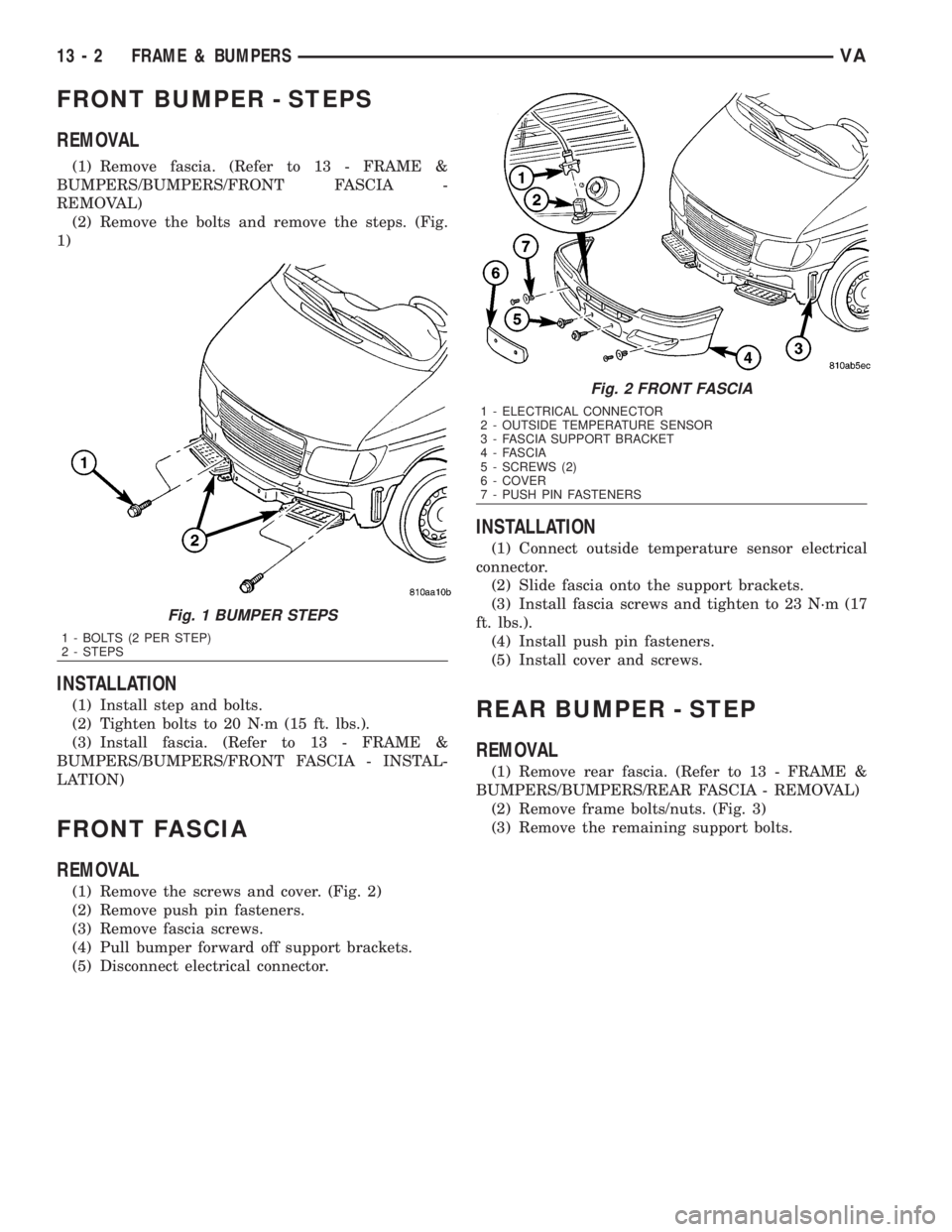
FRONT BUMPER - STEPS
REMOVAL
(1) Remove fascia. (Refer to 13 - FRAME &
BUMPERS/BUMPERS/FRONT FASCIA -
REMOVAL)
(2) Remove the bolts and remove the steps. (Fig.
1)
INSTALLATION
(1) Install step and bolts.
(2) Tighten bolts to 20 N´m (15 ft. lbs.).
(3) Install fascia. (Refer to 13 - FRAME &
BUMPERS/BUMPERS/FRONT FASCIA - INSTAL-
LATION)
FRONT FASCIA
REMOVAL
(1) Remove the screws and cover. (Fig. 2)
(2) Remove push pin fasteners.
(3) Remove fascia screws.
(4) Pull bumper forward off support brackets.
(5) Disconnect electrical connector.
INSTALLATION
(1) Connect outside temperature sensor electrical
connector.
(2) Slide fascia onto the support brackets.
(3) Install fascia screws and tighten to 23 N´m (17
ft. lbs.).
(4) Install push pin fasteners.
(5) Install cover and screws.
REAR BUMPER - STEP
REMOVAL
(1) Remove rear fascia. (Refer to 13 - FRAME &
BUMPERS/BUMPERS/REAR FASCIA - REMOVAL)
(2) Remove frame bolts/nuts. (Fig. 3)
(3) Remove the remaining support bolts.
Fig. 1 BUMPER STEPS
1 - BOLTS (2 PER STEP)
2 - STEPS
Fig. 2 FRONT FASCIA
1 - ELECTRICAL CONNECTOR
2 - OUTSIDE TEMPERATURE SENSOR
3 - FASCIA SUPPORT BRACKET
4 - FASCIA
5 - SCREWS (2)
6 - COVER
7 - PUSH PIN FASTENERS
13 - 2 FRAME & BUMPERSVA
Page 1670 of 2305
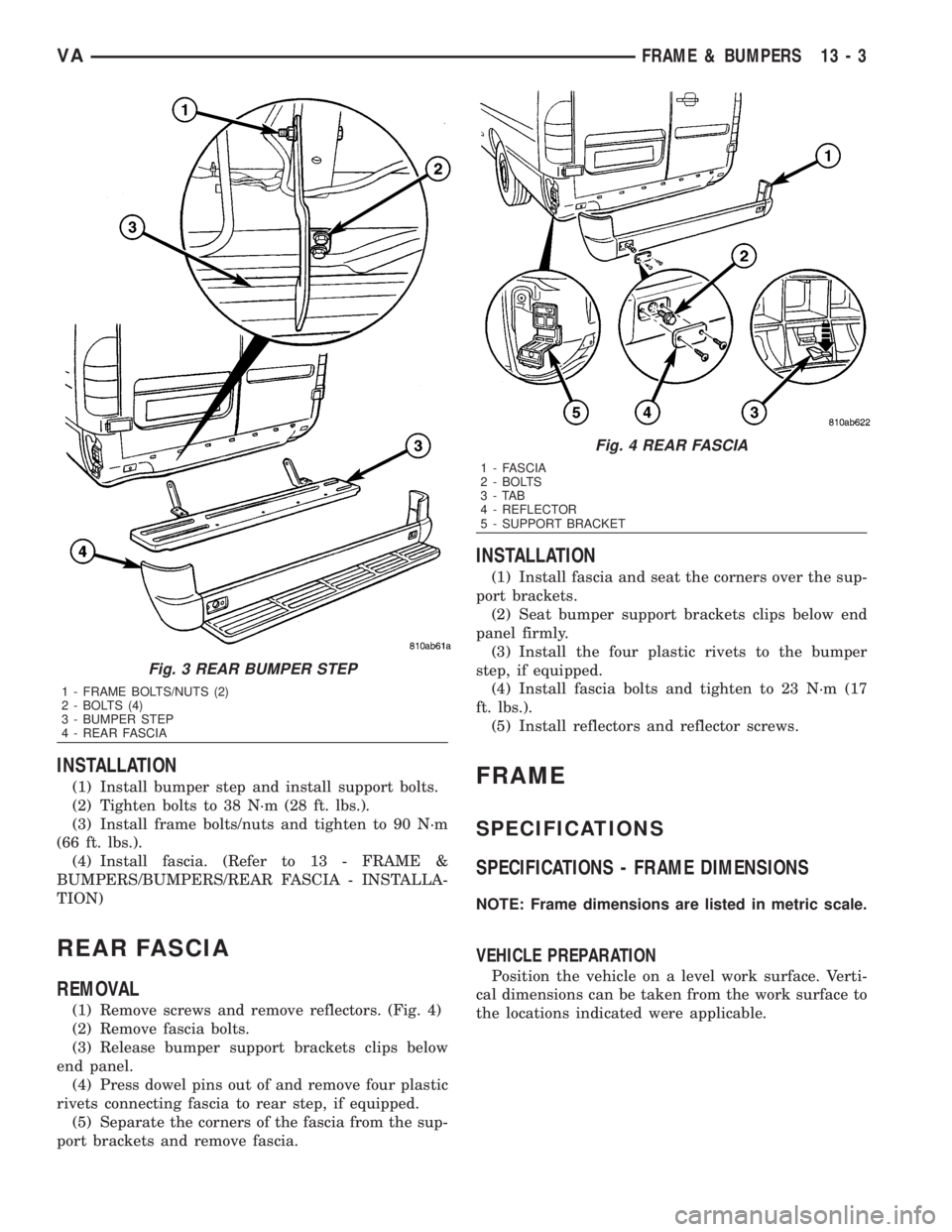
INSTALLATION
(1) Install bumper step and install support bolts.
(2) Tighten bolts to 38 N´m (28 ft. lbs.).
(3) Install frame bolts/nuts and tighten to 90 N´m
(66 ft. lbs.).
(4) Install fascia. (Refer to 13 - FRAME &
BUMPERS/BUMPERS/REAR FASCIA - INSTALLA-
TION)
REAR FASCIA
REMOVAL
(1) Remove screws and remove reflectors. (Fig. 4)
(2) Remove fascia bolts.
(3) Release bumper support brackets clips below
end panel.
(4) Press dowel pins out of and remove four plastic
rivets connecting fascia to rear step, if equipped.
(5) Separate the corners of the fascia from the sup-
port brackets and remove fascia.
INSTALLATION
(1) Install fascia and seat the corners over the sup-
port brackets.
(2) Seat bumper support brackets clips below end
panel firmly.
(3) Install the four plastic rivets to the bumper
step, if equipped.
(4) Install fascia bolts and tighten to 23 N´m (17
ft. lbs.).
(5) Install reflectors and reflector screws.
FRAME
SPECIFICATIONS
SPECIFICATIONS - FRAME DIMENSIONS
NOTE: Frame dimensions are listed in metric scale.
VEHICLE PREPARATION
Position the vehicle on a level work surface. Verti-
cal dimensions can be taken from the work surface to
the locations indicated were applicable.
Fig. 3 REAR BUMPER STEP
1 - FRAME BOLTS/NUTS (2)
2 - BOLTS (4)
3 - BUMPER STEP
4 - REAR FASCIA
Fig. 4 REAR FASCIA
1 - FASCIA
2 - BOLTS
3-TAB
4 - REFLECTOR
5 - SUPPORT BRACKET
VAFRAME & BUMPERS 13 - 3